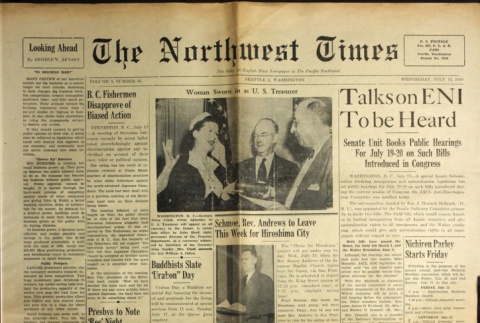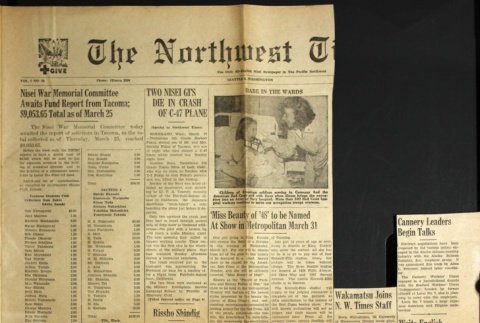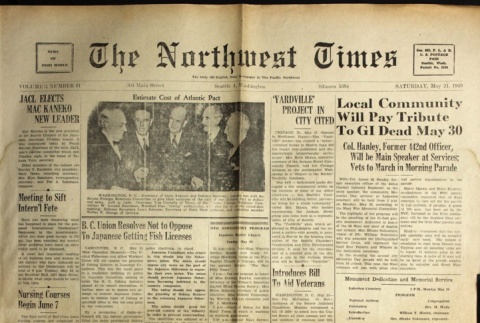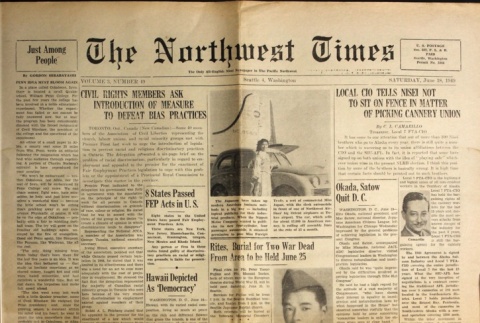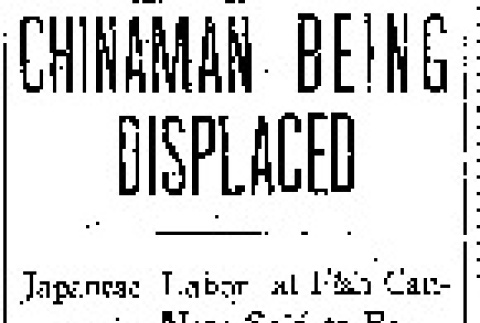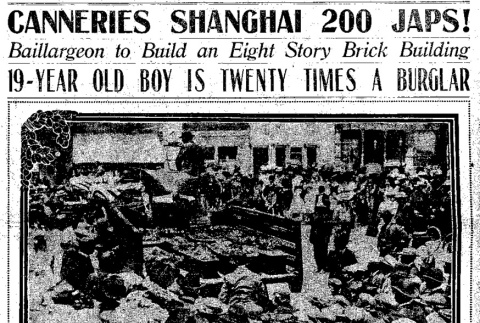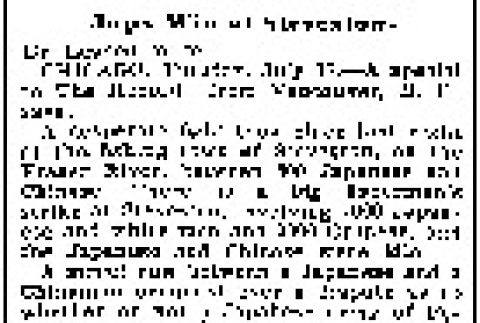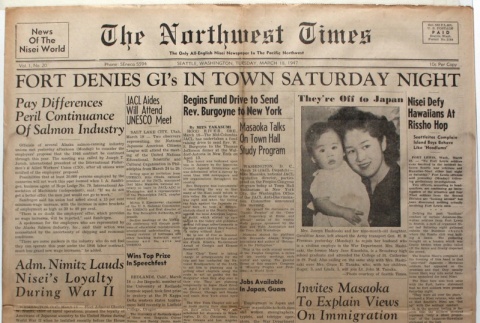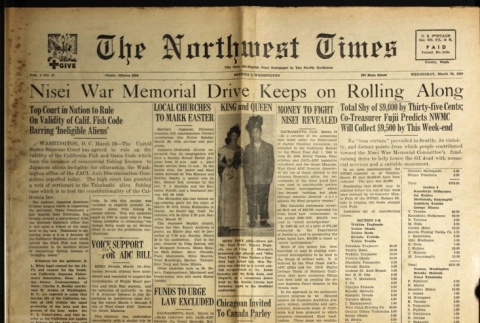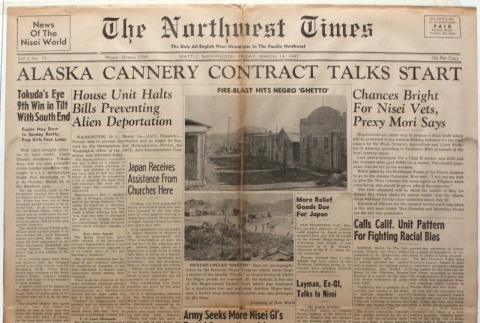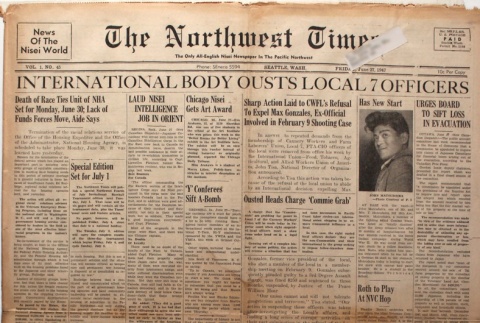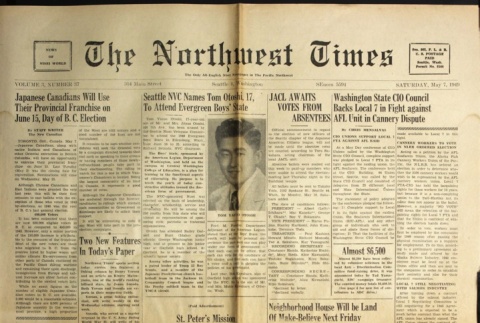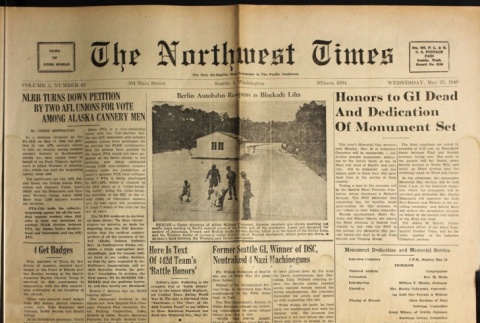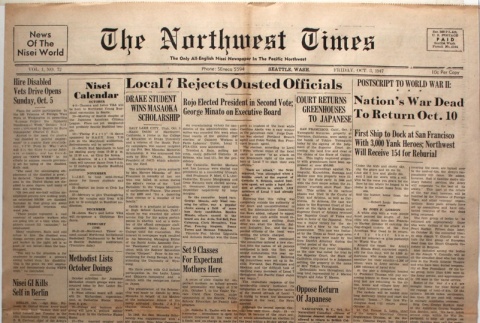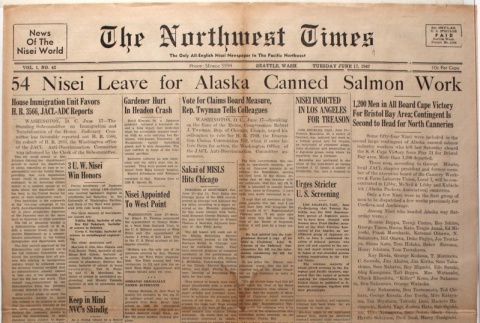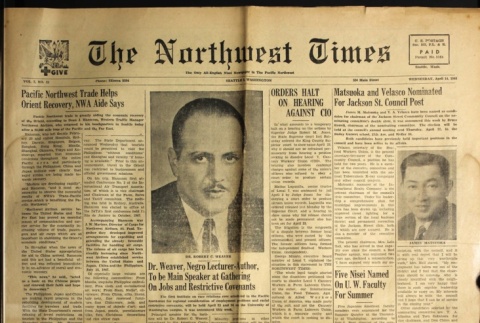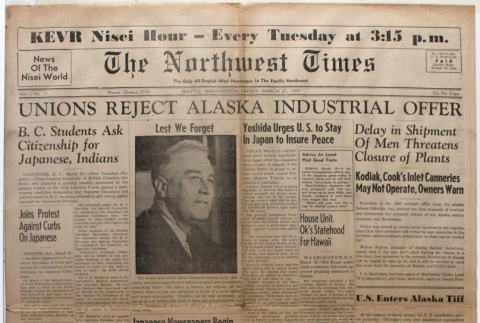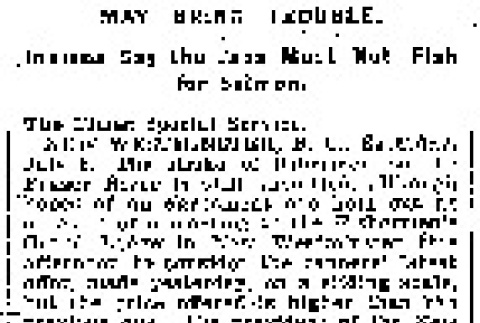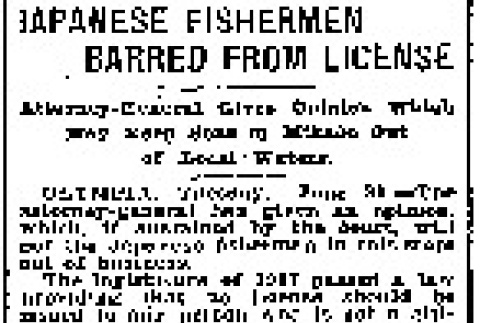Fishing and canneries
Japanese Americans found work at salmon canneries along the Columbia River in Oregon and Washington, and their labor was welcomed in Alaskan towns such as Ketchikan and Petersburg as early as the 1890s. They traveled by ship to the cannery towns, where they slowly developed small communities whose population swelled with the yearly arrival of workers. Issei (Japanese immigrant) entrepreneurs started the oyster industry from scratch in Puget Sound. Japanese American oyster farms became thriving businesses before World War II.
Industry and employment
(481)
Fishing and canneries
(256)
Related articles from the
Densho Encyclopedia :
Takahashi v. Fish and Game Commission
256 items
256 items
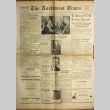
doc
The Northwest Times Vol. 3 No. 56 (July 13, 1949) (ddr-densho-229-223)
"B.C. Fishermen Disapprove of Biased Action" (p. 1), "Talks on ENI to be Heard" (p. 1), "Schmoe, Rev. Andrews to Leave this Week for Hiroshima City" (p. 1).

doc
The Northwest Times Vol. 2 No. 28 (March 27, 1948) (ddr-densho-229-98)
"Nisei War Memorial Committee Awaits Fund Report from Tacoma; $9,053.65 Total as of March 25" (p. 1), "Two Nisei GI's Die in Crash of C-47 Plane" (p. 1), "Cannery Leaders Begin Talks" (p. 1),
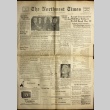
doc
The Northwest Times Vol. 3 No. 41 (May 21, 1949) (ddr-densho-229-208)
"B.C. Union Resolves Not to Oppose to Japanese Getting Fish Licenses" (p. 1), "Local Community Will Pay Tribute to GI Dead May 30" (p. 1),

doc
The Northwest Times Vol. 3 No. 49 (June 18, 1949) (ddr-densho-229-216)
"Civil Rights Members Ask Introduction of Measure to Defeat Bias Practices" (p. 1), "Rites, Burial for Two War Dead from Area to be Held June 25" (p. 1) "Local CIO Tells Nisei Not to Sit on Fence in Matter of Picking Cannery Union" (p. 1).
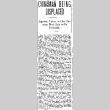
doc
Chinaman Being Displaced. Japanese Labor at Fish Canneries Now Said to Be Preferable. (June 11, 1904) (ddr-densho-56-43)
The Seattle Daily Times, June 11, 1904, p. 5
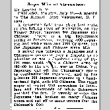
doc
Japs Win at Steveston. (July 17, 1900) (ddr-densho-56-17)
The Seattle Daily Times, July 17, 1900, p. 8

doc
Fishing Licenses To Be Denied Japanese (June 6, 1943) (ddr-densho-56-926)
The Seattle Daily Times, June 6, 1943, p. 4

doc
The Northwest Times Vol. 1 No. 74 (October 10, 1947) (ddr-densho-229-61)
"Nisei War Dead on Second Shipment of State Servicemen Killed in Action" (p. 1), "New Local 7 Cannery Union Officers Will be Installed on Nov. 1" (p. 1), "JCCC Promises Legal Experts for Japanese" (p. 4).
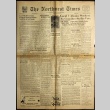
doc
The Northwest Times Vol. 2 No. 34 (April 17, 1948) (ddr-densho-229-102)
"A.V.C. Files Brief as Friend of Court in Takahashi Litigation; Assails Bias in Calif. Measure" (p. 1)," Local 7 Alaska Workers to Consider Strike Vote" (p. 1).
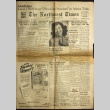
doc
The Northwest Times Vol. 2 No. 35 (April 21, 1948) (ddr-densho-229-103)
"Cabanilla Says: Local 7 Will Start "Throwing Punches' in Alaska Talks" (p. 1), "JACL Goes on Record as Backing Prompt Statehood for Hawaii" (p. 1), "U.S. Enters Takahashi Case" (p. 4).

doc
The Northwest Times Vol. 1 No. 20 (March 18, 1947) (ddr-densho-229-7)
"Fort Denies GI's in Town Saturday Night" (p. 1), "Pay Differences Peril Continuance of Salmon Industry" (p. 1), "Most Japanese Unaffected by Deportation Rule" (p. 2)

doc
The Northwest Times Vol. 2 No. 27 (March 24, 1948) (ddr-densho-229-97)
"Nisei War Memorial Drive Keeps on Rolling Along" (p. 1), "Top Court in Nation to Rule on Validity of Calif. Fish Code Barring "Ineligible Aliens" (p. 1), "Money to Fight Nisei Revealed" (p. 1).
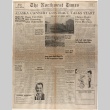
doc
The Northwest Times Vol. 1 No. 19 (March 14, 1947) (ddr-densho-229-6)
"Alaska Cannery Contract Talks Start" (p. 1), "House Unit Halts Bills Preventing Alien Deportation" (p. 1), "Army Seeks More Nisei GI's to Aid Occupation of Japan" (p. 1), "Republican Majority Votes to Kill State FEPC Bill" (p. 2).
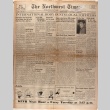
doc
The Northwest Times Vol. 1 No. 45 (June 27, 1947) (ddr-densho-229-33)
"International Body Ousts Local 7 Officers" (p. 1), "Urges Board to Sift Loss in Evacuation" (p. 1), "Death of Race Ties Unit of NHA Set for Monday, June 30; Lack of Funds Forces Move, Aide Says" (p. 1).

doc
The Northwest Times Vol. 3 No. 37 (May 7, 1949) (ddr-densho-229-204)
"Japanese Canadians Will Use Their Provincial Franchise on June 15, Day of B.C. Election" (p. 1), "Washington State CIO Council Backs Local 7 in Fight against AFL Unit in Cannery Dispute" (p. 1).
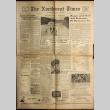
doc
The Northwest Times Vol. 3 No. 42 (May 25, 1949) (ddr-densho-229-209)
"NLRB Turns Down Petition by Two AFL Unions for Vote Among Alaska Cannery Men" (p. 1), "Honors to GI Dead and Dedication of Monument Set" (p. 1).
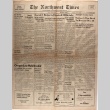
doc
The Northwest Times Vol. 1 No. 72 (October 3, 1947) (ddr-densho-229-59)
"Local 7 Rejects Ousted Officials" (p. 1), Postscript to World War II: Nation's War Dead to Return Oct. 10" (p. 1), "Court Returns Greenhouses to Japanese" (p. 1).
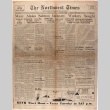
doc
The Northwest Times Vol. 1 No. 39 (June 6, 1947) (ddr-densho-229-27)
"Many Alaska Salmon Industry Workers Sought" (p. 1), "Report Cites B.C. Removal of Japanese" (p. 1), "Okada and Satow Will Speak Here Monday Night in Buddhist Church; Report on Claims Board Bill" (p. 1).

doc
The Northwest Times Vol. 2 No. 31 (April 7, 1948) (ddr-densho-229-100)
"Brief Raps Calif. Bill "Sheer' Bias" (p. 1), "Resignation of President Rojo from Local 7 Stirs Up Confusion Among Cannery Workers' Ranks" (p. 1), "U.S. Intelligence Officer Lauds Work of Nisei GI's in Japan War" (p. 1).

doc
The Northwest Times Vol. 1 No. 42 (June 17, 1947) (ddr-densho-229-30)
"House Immigration Unit Favors H.R. 3566, JACL-ADC Reports" (p. 1) "54 Nisei Leave for Alaska Canned Salmon Work" (p. 1), "Vote for Claims Board Measure, Rep. Twyman Tells Colleagues" (p. 1).
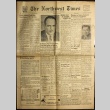
doc
The Northwest Times Vol. 2 No. 33 (April 14, 1948) (ddr-densho-229-101)
"Pacific Northwest Trade Helps Orient Recovery, NWA Aide Says" (p. 1), "House Will Hear Legislations on Naturalization April 19" (p. 1), "Orders Halt on Hearing Against CIO" (p. 1), "JACL to File Brief with Top Court to Back Takahashi in Fish Case" (p. 2).
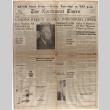
doc
The Northwest Times Vol. 1 No. 21 (March 21, 1947) (ddr-densho-229-8)
"Unions Reject Alaska Industrial Offer" (p. 1), "B.C. Students Ask Citizenship for Japanese, Indians" (p. 1), "Yoshida Urges U.S. to Stay in Japan to Insure Peace" (p. 1)
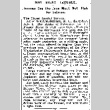
doc
May Bring Trouble. Indians Say the Japs Must Not Fish for Salmon. (July 6, 1901) (ddr-densho-56-22)
The Seattle Daily Times, July 6, 1901, p. 4
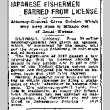
doc
Japanese Fishermen Barred From License. Attorney-General Gives Opinion Which May Keep Sons of Mikado Out of Local Waters. (June 30, 1908) (ddr-densho-56-129)
The Seattle Daily Times, June 30, 1908, p. 5
